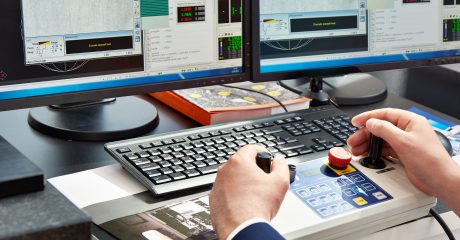Every CNC machinist needs to be able to do this simple step, and often having more than one way to do it is helpful. The amount of effort involved is not the same for each method, and some are better for special cases while others are more general. Understanding the whole arsenal of methods will help you to become more efficient by selecting the best one for each job. Keep on reading to discover each of the 10 methods!
Method 1: Use an Edge Finder
Edge Finders are by far the most common way to find part zero, so we’ll start there. To use this method, put your part in the milling vise or fixture. You’re typically going to make the corner part zero. Since you’ll be starting with unmachined material, it’ll be important to leave some allowance for machining in your CAD drawing. So, part zero sits in space rather than actually being on the part.
Method 2: Use a 3D Taster
Another very common, but more modern method is to use a “3D Taster”. 3D Tasters–often now called “3D Sensors”–were first made in Germany by a company called Haimer.
Method 3: Pick a Fixed Location on Your Vise or Fixture
This method is the most popular, as it requires the least time and effort for each setup, although it does require a little advance setup be done once. With the previous two methods, you have to find Part Zero every time you drop a new workpiece onto the machine. With this method, you find it once because it is relative to the workholding.
Method 4: Use a Stop of some kind
You can set the stop up to orient a part repeatedly to some part zero you measure to. You could also put stop features on a fixture plate as another alternative. Lastly, you can even get stops that fit in T-slots.
Method 5: Use a Camera or ‘Scope
Centering scopes have been around a long time and with enough care and magnification they can be quite accurate. But a more modern approach is to use a digital camera with magnification. Note that the camera is offset from the spindle centerline. That offset is fixed, and can be factored in when zeroing. There are also cameras that go right in a tool holder and will sight right down the spindle axis.
Method 6: Zero On a Part Feature
This is not an entirely independent method because you need to use one of the other methods to properly locate the part feature. But, it is extremely useful for second ops and cases where you have to put something other than a rough piece of material onto the machine, perhaps for a repair or reworking job.
Method 7: Endmill Plus Paper, Feeler, or Gage Block
Finding part zero with an endmill is another very common approach. The idea is to approach the part with the endmill and use a spacer of some kind so the endmill doesn’t actually contact the part. Common spacers include a piece of paper, a feeler gauge, or a gauge block. Except in the case of the paper, you will want the spindle to be stationary for this method.
Method 8: Laser Sight
This method is very visual, but not terribly accurate. You can mount a cheap laser in a toolholder that’ll project a nice red laser spot on your work that’s on the spindle axis.
Method 9: CNC Probe
A high quality CNC probe is automated and can be more accurate than any other method. Probes go in the spindle and use a stylus tip to probe the part. Using the right g-code, you could completely automate the process of finding Part Zero. Just put the code at the beginning of your part program and the operator can drop a part in the vise, push the green button, and let the machine figure out the rest. The main disadvantages they have is they’re going to be the most expensive method and the probes themselves can be damaged in a crash.
Method 10: Close Enough to “Eyeball”
With this method, you have written your part program to assume the part is buried some distance inside the workpiece. That distance determines how accurately you must locate part zero. If the part program is written to assume the part is 0.25″ inside the workpiece, then you need to make sure the workpiece is large enough to contain that much waste around the finished part and that the workpiece part zero is located within 0.25″ of the actual part zero. That’s such a large margin for error you can easily eyeball part zero.
Contact Custom Tool Today!
Finding Part Zero for some kinds of 5-Axis work or work on parts with complex shapes can be very daunting. But, after reading our blog, you now have 10 ways to manage Part Zero for your CNC Projects. For further guidance and to explore the best tools for your projects, consider reaching out to Custom Tool & Grinding for expert advice and quality solutions.
